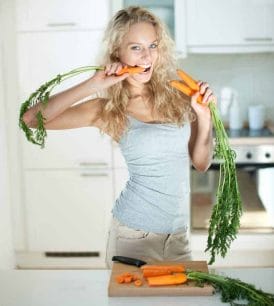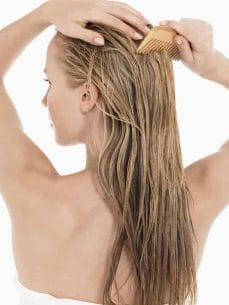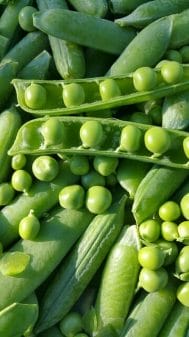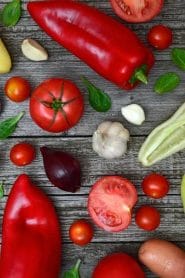The beauty of beautiful, shiny hair and long, thick eyelashes is probably the dream of every woman. However, fate is not kind to all of us in this area and therefore both require a lot of treatment to be the object of pride for women. Carefully nurturing these natural facial adornments, but not always realize that a variety of preparations, even the best, is not everything. Just as important as external conditioning is nourishing the hair from within. Studies have shown conclusively that a proper diet has a positive effect on hair and eyelashes, their beautiful appearance and good condition.
Table of contents
Causes of Problems with Hair and Eyelashes

Healthy hair is a visible symptom of good health of the whole body, and since the hair is an integral part of it, it needs the same nutrients. However, substances such as omega 3 fatty acids, B vitamins and certain micronutrients – silicon, iron, copper, iodine and zinc– are particularly necessary for their proper development.
A deficiency in vitamins and other substances due to an improper diet is one of the most frequent causes for poor hair condition and even hair loss. Other reasons for brittleness, fragility or excessive hair loss are environmental factors, long-term stress, taking some medications, sometimes serious disease or hormonal background.
While falling out or bad-looking hair easily draws our attention and prompts us to take immediate remedial measures, similar symptoms affecting the eyelashes are often neglected.
In addition to diet, their condition and appearance is greatly affected by makeup and makeup removal. Inappropriate cosmetics and preparations, not washing the eyes at night, extending thin and delicate eyelashes, frequent use of an eyelash curler, all this makes these extremely sensitive hairs languish and fall out.
Read also: How to strengthen your eyelashes
Even the most expensive preparations and the most careful treatments will not help if we do not learn how to properly treat eyelashes and above all if we do not start to nourish them, just like hair on your head. It is worth remembering this especially when you decide, for example, intensive weight loss and a restrictive diet.
How do you care for your hair and eyelashes?

The most important thing is to eliminate factors, which have a destructive effect on hair. In the case of eyelashes it is resignation or at least limitation of artificial procedures in the form of extensions or curling, make-up using good cosmetics and careful, gentle make-up removal. In the case of hair as infrequent use of hair straighteners, curling irons, hair dryers, styling products, abandonment of poor quality dyes and limit coloring, not too frequent teasing and brushing.
You should systematically use good care cosmetics, conditioners for hair and eyelashes or home rem edies with proven beneficial effects. In terms of ready-made preparations, depending on the needs, for example, we reach for cosmetics with proteins for damaged hair, with humectants, i.e. moisturising substances for dry, brittle and inflexible hair or with emollients, which form a protective layer on the hair surface.
Check: Eyelash conditioner ranking
There are also proven natural remedies to improve the condition of hair and eyelashes. These include castor oil, which contains the most valuable nutrients, namely fatty acids, vitamins A, E and B, beta carotene and iron. Castor oil combined with raw egg yolk and lemon juice and applied as a compress on the head can work wonders and an improvement in the hair condition is visible after just one treatment.
Soy and wheat germ extract is also used in hair care. It contains B vitamins, minerals and panthenol, which plays a very important role in hair regeneration, moisturising it and creating a protective barrier. No less important than conditioners is also a skilful choice of shampoo appropriate for your hair type and potential problems. However, we must remember that all the described treatments and measures may prove to be insufficient if the body, and thus the hair or eyelashes, do not receive sufficient amounts of the necessary nutrients.
Diet for hair – substances necessary for its development
The structure of a hair consists mainly of proteins, fats and minerals. The most important part of the hair is the bulb, which grows out of the follicle. The hair follicle grows out of the hair follicle. The blood brings nutrients into the hair follicle and supplies the hair bulb with these nutrients. However, the body must have sufficient nutrients to supply the hair, because in case of a shortage of nutrients, the most important vital organs are supplied first and hair and nails are supplied last.
Therefore, any deficiency, whether of protein, silicon, iron, vitamin B or zinc, almost immediately affects the condition of the hair. Dietary mistakes also have a detrimental effect on hair: Excessive use of alcohol, strong coffee and tea, too much animal fat, sugar and some vegetables containing oxalates (sorrel, spinach, rhubarb) block the absorption of calcium, magnesium and zinc.
The substances your hair needs include:
- protein and fatty acids – essential building blocks of hair
- Zinc and copper – essential for hair’s strength and shine
- silicon – which accelerates growth and has a strengthening effect
- iron – affecting the correct structure of hair and its growth rate
- calcium and magnesium, which have a beneficial effect on the condition of hair
- B vitamins – regulating sebum secretion, improving the structure and shine
- Vitamins A, E and C, which have antioxidant properties and are beneficial for the condition of hair
Where do you find the nutrients your hair needs?

Protein and sulphur-containing amino acids can be obtained by eating fish, eggs, beans, beef and vegetables such as cabbage, broccoli, cauliflower, watercress, black turnip, radish, horseradish and onions.
Zinc can be found in seafood, legumes, whole grain cereals, nuts and pumpkin seeds. Sources of copper include liver, nuts, seeds, cocoa, and oatmeal.
Silicon, which is very important for hair, is supplied by oat bran, oatmeal, dairy products, rice, beetroot, garlic, onions, and natural spring water.
Iron can be found in meat, especially poultry and green leafy vegetables, and magnesium in bran and cereal products, milk, meat and nuts.
B vitamins found in various foods play a very important role, namely:
- B1 – in buckwheat groats, yeast, nuts and almonds, oatmeal, wholemeal bread, eggs and vegetables and fruits – tomatoes, potatoes, cabbage, cauliflower, legumes, grapefruits.
- B2 – in bran, yeast, corn, green peas, cauliflower, spinach, celery, apples.
- B3 or niacin – in whole-wheat flour, kale, spinach, asparagus, sunflower seeds and nuts.
- B5 – in freshwater fish, eggs, beans, parsley, cabbage, strawberries and citrus fruits, and bee pollen.
- B6 – in buckwheat groats, potatoes, cabbage, carrots, spinach, asparagus, bananas, and nuts.
- B7 or biotin – in liver and egg yolks, poultry, seafood, whole grain flour products, tomatoes, carrots, spinach, mushrooms.
- B8 or inositol – in whole grain products, tomatoes, beets, cauliflower, kale, cabbage, citrus fruits.
- B9 or folic acid – in vegetables such as spinach, asparagus, carrots, parsley, potatoes, turnips, lentils, beans, chicory, wheat germ, rice, soybeans, egg yolks, oranges, brewer’s yeast.
It is impossible to omit vitamin C, which abundant sources are blueberries, black currant, chokeberry, rosehip, cranberry, citrus fruits, strawberries, kiwi, papaya, gooseberry, peppers, tomatoes, kale, green parsley, Brussels sprouts, cabbage, kohlrabi, broccoli, green beans, spinach.
Called the vitamin of youth, vitamin E is also essential for hair health. It can be found in vegetable and olive oils, walnuts and hazelnuts, almonds, pumpkin and sunflower seeds, peppers and parsley, tomatoes, spinach, garlic, carrots, cabbage and lettuce, as well as wholemeal bread, bran and oatmeal, dairy products, among others.
Read also: Collagen – a natural recipe for youth and health
Hair Diet – How to Compose a Menu

There is no doubt that a healthy diet should be based on vegetables and fruit, which is beneficial not only for our hair but also for the functioning and condition of the whole organism. The abundance of various vitamins and minerals, and above all, numerous antioxidants, helps to maintain health and a young appearance.
The so-called colorful diet for hair, eyelashes, vitality, health and slim figure will probably be helpful in forming a proper menu.
Color diet classifies plant products by color, and from the ingredients of each of these groups should be arranged daily menu:
- Red products: tomatoes, peppers, strawberries, strawberries, raspberries, cherries, pomegranates, watermelon.
- Orange products: carrots, yellow peppers, potatoes, pumpkin, courgette, squash, peaches, mangoes, oranges, apples.
- Green products: spinach, parsley, kale, green peppers, salads, asparagus, peas, beans, broccoli, Brussels sprouts, cabbage, watercress.
- Violet products: berries, blueberries, blackberries, plums, grapes.
Of course, our menu cannot lack whole-grain cereals, dairy products, lean meat, eggs, fish, nuts, seeds or sprouts. However, while daily consumption of vegetables and fruits is highly desirable, when it comes to meat or eggs, we should limit their consumption to 2-3 times a week.
- Breakfast – oatmeal on milk with nuts, a slice of whole grain bread with ham and lettuce or kale.
- Second breakfast – fruit salad, mineral water.
- Dinner – cream of pumpkin, lentil, broccoli or green pea soup, buckwheat groats, fish baked in foil, carrot and cabbage salad, vegetable or fruit juice.
- Afternoon snack: home-made millet cakes, water with lemon.
- Dinner: cottage cheese with radishes, chives or spring onions, pumpernickel, tomato and pepper salad.
- Breakfast: graham with mackerel and cream cheese paste, salad of green salad, rocket, orange and sunflower seeds with a little olive oil and lemon juice.
- Second breakfast: yoghurt with muesli, half a grapefruit.
- Lunch: beetroot cooler, brown rice, chicken breast stewed with herbs and mushrooms, salad of celery, fresh pineapple and parsley.
- Afternoon snack: fruit mousse.
- Dinner: wholemeal bread, hard boiled eggs, salad of avocado, fresh spinach and tomatoes.
Neither thorough hair care nor a healthy diet will suddenly transform naturally thin, fine hair into abundant curls. It is also impossible to stop the unfavourable changes caused by ageing or hormonal disturbances. However, they can certainly be slowed down and alleviated and if weak, miserable hair is the result of our neglect, they can be restored to their former appearance and shine.
Apart from a proper diet, it is worth reaching for supplements, which have been specially prepared for hair regeneration, strengthening and restoring its beautiful appearance. An excellent product in this category is Locerin, which contains two rich sources of silicon as well as a whole range of other substances needed by hair.
Learn more about the dietary supplement Locerin

We also recommend: Eleverlash eyelash conditioner review

